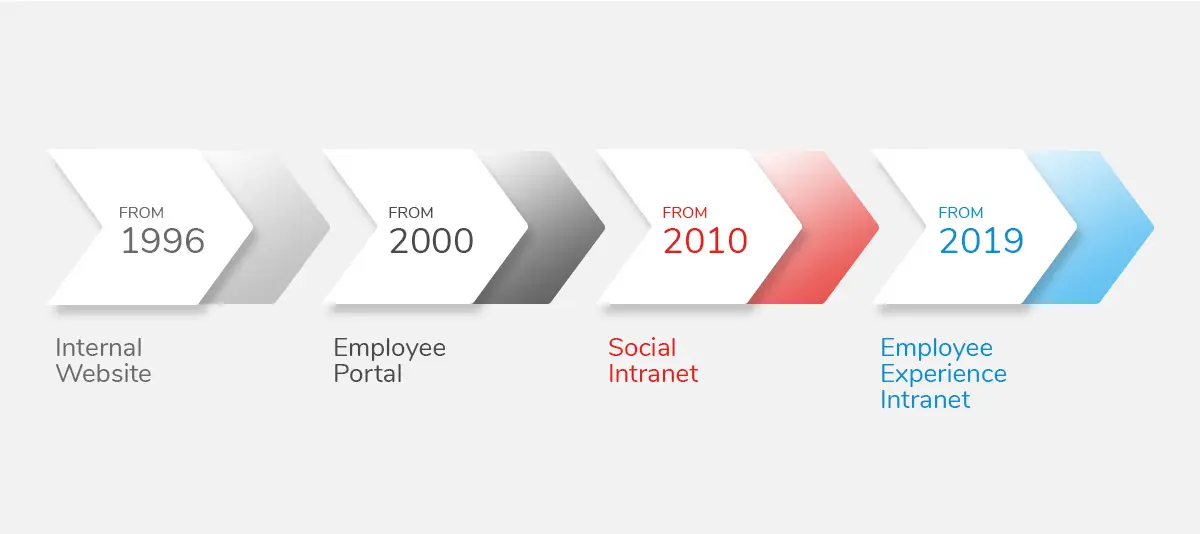
That hybrid work style that so many of us dreamed of—but never managed to pull off—became a reality with the advent of the pandemic. And now, it’s here to stay.
According to Jenni Field, founder and director of Redefining Communications, and author of the book Influential Internal Comms, "A crisis will escalate existing trends".
Because of this paradigm shift within the labor ecosystem, we no longer depend on one or several specific locations to define what a company is. Today, more than ever, an organization’s culture is a vital asset, and the intranet is the materialization of the ideas that are part and parcel of its identity. The fluid, digital workspace has gained ground, and now it’s known as a digital employee experience.
The evolution of company intranets
The goals of a company intranet have mutated over time. For this reason, it’s quite useful to take a brief look at how they came to be, as this will help us to better classify how they have developed more recently.
Broadly speaking, there are four different generations of intranets:

Internal websites and employee portals still tend to be widely used today as intranets. They generally have a large amount of information available, all within the same tool. New intranets are seldom designed like this, as today’s concept is about having applications for every function, whether video conferencing, sharing work files, interacting with peers, or viewing company news.
1st generation. The internal website
A company’s internal website tended to be based on the same technology as the external website, a practical solution as the license was usually already paid for, and the IT department already had the necessary know-how to manage the technology within the company, or through an external partner such as an agency.

Limitations:
- Information distribution is unidirectional: top down.
- No interaction with the audience.
- Integration with external services either not possible or very complex.
- No option to customize content.
- Editing a technically complex task, making content likely to get outdated.
- Customized solutions difficult to maintain.
- Optimized only for Desktop use.
2nd Generation. An employee portal
A desire to integrate services from other applications into the intranet, such as a personnel system, drove this change in how people understood the intranet. Employee portals were largely based on software specializing in integrations and processes, rather than in the creation and management of content, such as static pages and news.

Limitations:
- Expensive
- Information distribution unidirectional: top down.
- External services could be integrated but still a very expensive exercise.
- Publishers found it complex to use and quite often the result lagged behind internal websites.
- Optimized only for Desktop use.
3rd generation. The social intranet
The emergence of social intranets mirrored what was happening with the Web 2.0. Interactive applications, such as wikis, blogs and social networks, brought user interaction to the fore, which was also one of the principal objectives of social intranets.

Limitations:
- Social intranets are very confusing when it comes to transmitting structured content, as each user can easily create new content.
- Personalization of content and services depends very much on the individual user, and most users don’t personalize these.
- Mobile channels are often available, but overall, the content, structure, and complexity are still most accessible for desktop users; mobile usage of social intranets is often surprisingly low.
- The arrival on the scene of team chat solutions, such as Slack or Microsoft Teams, allowed these to take center stage thanks to better practices and experience.
Latest generation: User Experience Intranet
In the first three intranet generations, a typical intranet user would sit at a desk in front of their PC. Today, given the increasingly varied demands of mobile intranets, usage scenarios are fragmenting and becoming more diverse.

This new generation of intranets builds on cases of proven use from the previous intranet generations, focusing on mobile access and personalization, where the offer is evolving considerably. New intranets include a range of community building and interaction tools, such as surveys that measure workplace climate, the ability to pick up on both trends and potential risks within internal communication, benchmarking progress, etc.
The result is an intranet that offers the clarity of the first generation, the integrational strengths of the second, and the interaction of the third, all rolled into one single platform.
Limitations:
- A deliberate limitation of these intranets is that they don’t have virtual team rooms for digital collaboration. The assumption is that other platforms, such as Slack or Microsoft Teams, do provide these functions.
- Strictly confidential content is not suitable for DEX (Digital Employee Experience) intranets and needs to be stored on other platforms, such as Google Drive or Dropbox.
- The intranet DEX concept is new, and only being used by a few dozen companies. By extension, the content and technical design of these intranets still offer ample opportunity for further optimization.
Modern intranets become relevant through customizable and value-added content.
The use of intranets is often voluntary, especially when private and mobile devices are used. Therefore, an intranet needs to focus on the added value and relevance provided to the user.
Appropriate content, managed as automatically as possible on the basis of an employee's location, team, role, interests, or background, will create relevance. However, successful customization not only builds relevance but also reduces complexity. As organizations become more global, complex, and agile, and screens get smaller, complexity can become a significant barrier for many users.


This illustration shows how individual requirements regarding devices and content, as well as different usage behavior, can vary substantially among employees according to role, location, etc. Modern intranets must be able to overcome these challenges to make the user experience as personal and useful as possible for each employee.
